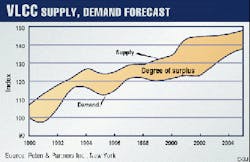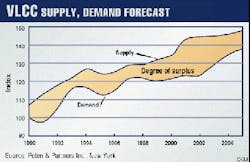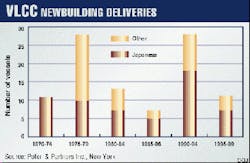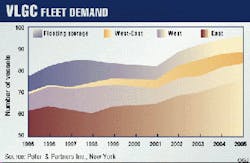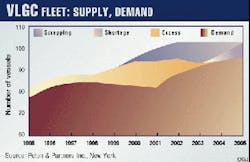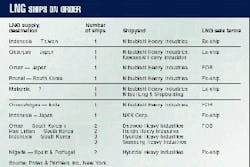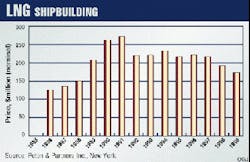Changing trade patterns and evolving technologies will alter traditional shipping patterns and fleet changes in liquid petroleum product, LPG, and LNG carriers into the 21st Century.
Eastern economies reviving from a recent sharp downturn may draw off toward the east historical crude oil trade from the Arabian Gulf (AG) area. And shrinking export supplies of LPG may force a tightening in that market. Finally, the traditionally conservative LNG supply-demand chain may be on the verge of loosening its trade structure.
Oil consumption, Middle East exports
Throughout most of the world, alternative forms of energy have marginally replaced oil, except for Asia where oil has gained a greater share of the energy pie. The Asian nations in economic retreat have already either stabilized or turned the corner.
Oil consumption is already growing and will revert to the growth rate of the first half of the 1990s by 2002 or 2003. In the Atlantic basin, oil consumption and imports into Europe will expand modestly through 2005. North American oil consumption and imports will likely increase at historical rates throughout the projection period.
Middle East exports are essentially a netting exercise of world oil import demand less non-Middle East sources. For the Atlantic basin, oil export availability is projected to increase in West and North Africa, Latin America, North Sea, and the newly emerging Caspian Sea.
This netting exercise, however, implies that Saudi Arabia will remain idle as Venezuela and other Atlantic basin exporters displace Saudi Arabia in the Atlantic basin. Events in 1998 and 1999 proved otherwise.
Venezuela's intention to displace Saudi Arabia in the US market was making progress in 1997 as seen by the falling number of AG crude shipments in VLCCs to the Caribbean.
This was expected to worsen in 1998, but it did not happen. Saudi Arabian crude shipments increased, followed by a sharp fall in crude prices in early 1999. Then Saudi Arabia called a meeting of the major oil producers for a concerted action on production cutbacks.
It was rumored that Saudi Arabia also reached an agreement with the Atlantic basin oil exporters on its share of the US market. The reward for following Saudi Arabia's desires was a rise in prices.
This agreement has a major bearing on VLCC prospects, as the longest trade is AG/West via Cape of Good Hope. Venezuela pushing Saudi Arabia out of the US market would have had extremely adverse repercussions for VLCC owners. Thus, the forecast for demand is not a strict netting exercise but includes a provision for continued Saudi presence in the Atlantic basin.
While Middle East exports will likely grow, the growth will be AG/East rather than AG/West. This has adverse effects for the prospects of both VLCC and Suezmax tankers.
VLCC prospects
Very large crude carriers (VLCCs) depend on AG exports. While exports are expected to grow, the continued shift from AG/West to AG/East liftings will have the net effect of leveling tonne-mile demand until 2002. This is not good news for VLCC owners as the fleet is expanding from a large number of newbuilding deliveries.
Scrapping activity is critical to restoring the supply-demand balance for VLCCs. The potential opening of two Iraq-Syria pipelines will cut into the Cape of Good Hope trade, a mainstay of VLCC employment.
The analysis assumes that the proposed pipelines open but that their effective throughput is modest. Orders for more newbuildings made since the start of the Asian financial crisis plus those already on order will cause a "bubble" of over-capacity that will keep short-term rates depressed.
VLCC supply will be reduced by the MARPOL phaseout schedule that affects large numbers of VLCCs built during the mid-1970s (MARPOL = Marine Pollution Convention). The phaseout schedule depends on oil company acceptance of hydrostatic balanced loading. There are conflicting signals as to its potential use.
Current low rates, high bunker costs, and long waiting times for cargoes may convince owners that there is no point in hanging on to older tonnage any longer.
Rates cannot increase until there has been a substantial reduction in the supply of vessel capacity through lay-up, or better yet, scrapping. The supply demand forecast illustrates the over-capacity bubble, which is reflected in the rate forecast (Fig. 1).
A modest rise in rates is projected before the surplus bubble is liquidated, reflecting the market's penchant to sense anticipated changes in the balance between supply and demand.
LPG shipping outlook
LPG ships vary in shape and size:
- Fully refrigerated very large gas carriers (VLGCs) of 70-85,000 cu m, mostly involved in long-haul LPG trades.
- Fully refrigerated mid-sized gas carriers (20-60,000 cu m) that ship LPG and anhydrous ammonia as well.
- Semirefrigerated, semipressurized gas carriers (generally 20,000 cu m or less) that also transport chemical gases such as propylene, butadiene, and vinyl chloride monomer.
- Small pressure gas carriers (generally less than 6,000 cu m) that are mostly involved in coastal and other short-haul trades.
The LPG fleet afloat totaled 920 at the end of 1998. But it was the 89 ships in the VLGC fleet that transported 70% of the 45 million tonnes of LPG that moved in world trade in 1998.
Japan and the rest
The VLGC fleet has been traditionally divided into two segments: that controlled by Japanese charterers and shipowners and dedicated to Japanese import trades (slightly less than a third of world LPG trade) and the rest operating under a variety of trades and ownerships.
The ordering by Japanese shipowners has been more consistent than that by other owners. These vessels, once delivered, normally operate under long-term charters at fixed rates that are relatively immune from the short and medium-term fluctuations in the shipping market. And when these charters expire, a replacement vessel will be ordered.
Ordering by other owners has been more market-related. It is either tied to specific projects or trade flows or to an observed tightening in the supply-demand balance (reflected in rising charter-hire rate levels).
There have been two spates of VLGC newbuilding ordering in the past, one in the late 1970s and the second in the early 1990s (Fig. 2).
This has given a curious imbalance to the current trading fleet: a large number of 20+ year vintage, few between 10 and 20 years, and a significant number of modern ships.
A third newbuilding wave is under way. The current orderbook shows 14 (with a further 2 options) for delivery from second half 1999 through 2001. The incentive this time has been attractive yard prices.
Yard prices are little higher (in US$ terms) than they were 20 years ago when the first VLGC newbuilding wave occurred. And the newbuildings now are much more fuel-efficient than the vessels that were built then.
How then will all these vessels be utilized?
Floating storage; trading alternatives
Employment prospects for the older vessels might have been bleak in the mid-1990s but for the trader-initiated move into break-bulk floating storage operations off China. During 1998, as many as eight VLGCs were being deployed at one time as floating storage to supply this booming import market.
The start-up of fixed storage onshore in China, however, has taken this throughput away and reduced the floating storage requirement. By mid-1999, no more than two or three VLGCs were operating in this mode. The surplus vessels, once redelivered, have ended up in the spot trading market.
And, each month of 1999, prospective charterers have had a wide array of vessels to consider for any spot shipping needs. The surplus in the spot market has also persuaded some charterers to cut back on their term-chartering of VLGCs.
The VLGC fleet very much depends on LPG supplies available out of the Middle East (which, by themselves, account for more than half of the LPG in world trade).
Unfortunately, export supplies there will not be expanding in the medium-term (2000-2002) because of constraints on export availabilities. Saudi Arabia's LPG exports will drop at that time as new petrochemical projects there come on stream. These will absorb LPG currently being exported.
This development will be negative for LPG shipping in that there will be less LPG to transport but positive in another. The Eastern importing market (Japan, Korea, and China) will be short of LPG and will have to source some of their supplies from further-away exporting areas.
Over this period, therefore, growth in West-East LPG trades will take place from the US Gulf (mainly in winter) and from Algeria, Nigeria, and the North Sea (mainly in summer).
Fig. 3 summarizes the trend in VLGC demand-in floating storage and in LPG trades East, West, and West-East-anticipated over the next 5 years.
Supply, demand; scrappings
It is unlikely that, at least until 2002, ship demand will keep pace with supply (Fig. 4).
The supply-demand balance for VLGCs suggests that there will be 3 difficult years for shipowners-1999, 2000, and 2001. VLGCs will experience extended waiting times in spot markets. Surplus ships may find spot employment from time to time in clean products carriage. But there could also be some vessel layups.
Restoration of a supply-demand balance assumes that owners will then begin to scrap ships. There is a large pool of 1970s-generation gas carriers afloat. By 2005, their average age would be 30 years.
How quickly they disappear from the trading fleet will determine the new shipping opportunities in VLGCs.
A vessel needs to remain in class to remain seaworthy. This requires regular surveys. If an LPG ship is to last 30 years (as many can), the shipowner will at that time face major commercial decisions. A very extensive (and expensive) special survey becomes due then.
Many owners, even those who have maintained their fleets well, may contemplate scrappings at that time, some possibly before that date.
An older vessel is likely to stay in the trading fleet as long as its resale price remains sufficiently positive against the scrap value. In 1997 and 1998, with the boom in Chinese floating storage, older ships commanded prices greater than $20 million (US).
The most recent deal has been closer to $5 million. Any further significant downward movement in this valuation and scrapping is likely to become a reality for some vessels.
Market upturn?
The shipping industry is used to cyclicality. The lead time of 2 years or more in ordering a vessel means that the ship may well be delivered in different market circumstances than in those at the time the vessel was ordered.
That will be the case in 2000. A VLGC supply increase will coincide with a drop in demand for these vessels. A temporary oversupply will ensue.
Future market signs are optimistic, however. LPG is a supply-driven industry. New export supplies will appear on the market in 2001 or later from a variety of sources from the Middle East (Qatar), Australia, Papua-New Guinea, Nigeria, Norway, and Venezuela, and all of these export volumes will require ships to move them.
And the shipping market is anticipatory. As soon as there are signs that the surplus is going down, charterers will begin to fix forward ships again. This forward fixing will tend to push up charter-hire rate levels ahead of any actual market tightening.
The rate improvement then will probably not be uniform across all segments of the VLGC fleet. A rate differential of $100-120,000/month already exists between the new and older vessels in the fleet because of differences in performance and other factors. This differential will probably widen in the years ahead.
Some charterers have policies not to fix ships on term-charter beyond a certain age; and some older vessels may not be acceptable on certain trade routes. A number in fact do not have IMO classification and US Coast Guard compliance and have only a limited arena for LPG trading.
These various factors will tend to lead to a wider rate differential for VLGCs in the future as a result of vessel age.
LNG shipping
In a specialized sector of the marine business is LNG shipping.
Although the ships utilize technology unique among other tankers, an equally important difference is that employment of ships is fully committed before orders are ever placed with shipyards.
In this respect, LNG shipping reflects the business approach that has prevailed in the LNG industry since inception. The physical elements of a new LNG trade, gas production, liquefaction, ships, and import facilities are costly. As a result, the chain is fully defined before investment decisions are made.
LNG buyers and sellers enter 20+ year LNG sale and purchase agreements (SPAs) linking the buyer and seller. One of the myriad issues established during the negotiations leading up to the SPA is responsibility for shipping, and this often includes a requirement to provide new purpose-built ships.
LNG shipping is costly. Depending on the length of the transportation route, shipping for a new LNG project might cost from $0.60 to $1.00/MMbtu and account for 20-35% of the total delivered cost of LNG.
The high cost of LNG shipping results from three major factors:
- Specialized designs, systems, and materials of construction are required to transport LNG at -163° C. and atmospheric pressure.
- The low specific gravity of LNG (0.46) and resulting low energy density requires a large volumetric capacity to deliver a relatively small energy content.
- As the LNG ship is a key link in the project chain, both LNG sellers and buyers demand high standards in design, construction, and operation.
Because of the high costs of transportation, ships are typically built to meet a contractually defined, long-term commitment to transport LNG that is being sold under a long-term SPA.
A few ships have been constructed on a speculative basis, in anticipation of future employment, and some of those ended in lay-up for as long as 23 years before finding employment under new owners.
Today's LNG fleet consists of 108 actively trading LNG ships plus 3 ships in lay up. However, 2 of the latter are being reactivated and will soon return to service. The final ship in lay up, Arzew, is expected to enter the shipyard later in 1999 for reactivation and return to service in mid-2000.
In addition to the existing fleet, there are 21 new ships on order at eight shipyards.
Table 1 shows ships on order, shipyard, and LNG trade routes the ships will serve. The table shows that Asian shipyards have all the current orders for new LNG ships. Korean shipyards with orders for 12 ships have the bulk of the new LNG ship construction business, and this is tied to the fact that 10 of the ships on order will transport LNG to Korea.
Because LNG business is still a contract business, one can also see where the next tranches of LNG supply are destined: 10 ships to Korea, 4 ships to Japan, 2 ships to Spain and Portugal, and 1 ship to India's Dabhol project.
The two ships ordered for Malaysia LNG are an interesting exception to the rule that ship employment is fixed before the ships are ordered. No specific LNG contracts have been signed at the time of order, and no specific LNG trade route has been designated.
Of the 12 ships under contract with Korean yards, 10 are for Korean owners that have long-term contracts of affreightment with Korea Gas Corp. (Kogas). These ships, and 3 delivered earlier in 1999, will transport LNG that Kogas has purchased from Indonesia's Bontang LNG and from Middle East suppliers Ras Laffan LNG and Oman LNG.
The other two ships on order at Korea's Hyundai Heavy Industries are for Nigeria LNG. They are significant in two respects:
- They are the first Korean built ships for non-Korean owners and LNG trade routes.
- The ships were reported to have a shipyard price in the low to mid-$160 millions, a very low price reflecting today's very competitive shipbuilding industry.
Fig. 5 shows the significance of the new ship prices reported in 1999. Shipyard prices for ships ordered in 1985 and 1986 were reported to be in the range of $125 million each. Prices climbed steadily through 1991, when they peaked.
In 1991-92, Korean shipyards received their first LNG ship orders from domestic owners, and in 1992 Finland's Kvaerner Masa shipyard placed an extremely competitive bid for four ships to replace existing ships whose charters were scheduled to expire at Abu Dhabi's Adgas project. Competition among shipyards has driven prices lower.
Today, Korean shipyards are offering very aggressive prices in an effort to capitalize on the experience they have gained from the design and construction of ships for Korea Gas.
The technical specifications of LNG ships have changed little in the past 25 years. In some respects, this is a positive reaction to the technical success of early ships. It is also a reflection of a conservative business that seeks reliability in proven technology and a reluctance to change what works well in the specialized LNG service.
The standard size ship has gone from 125,000 cu m LNG capacity to 137,500 cu m. Three basic LNG containment systems, Kvaerner Moss spherical tanks, Gaz Transport, and Technigaz, continue to dominate the industry.
The propulsion systems utilize steam turbines, a technology that was abandoned by the marine industry in the 1970s. It is well suited for LNG, however, because the system can be easily adapted to use as propulsion fuel the LNG that boils off during a voyage.
Shipbuilding construction technology has improved and, of course, automation, control, and instrumentation systems have been upgraded significantly. But at heart the ships are remarkably similar to designs built 25 years ago.
The shipbuilding industry continues to press the idea of new propulsion systems, primarily diesel engines like the rest of the industry.
In the mid-1980s, Japanese shipbuilders spent considerable time and effort developing the dual-fueled, slow speed diesel engine for the Australia North West Shelf tender. At the end of the day, Australia NWS participants decided to stick with the proven steam-propulsion systems.
Now the European Union, in cooperation with Wartsila Diesel, Chantiers de l'Atlantique, Shell, and Lloyd's Register of Shipping, has funded a development project for a dual-fuel, medium-speed diesel engine.
In another technical development, the owners of the ship that will transport LNG from Oman LNG to Osaka Gas are installing a partial reliquefaction system aboard their ship. Onboard reliquefaction would give designers the opportunity to install diesel engines and not worry about dual-fuel applications.
Changing business
Change is also beginning to appear in the structure of LNG business. In a departure from only long-term sales, short-term LNG sales rose to match uncommitted liquefaction capacity with unfilled LNG demand. More recently, projects are being started with only a part of their capacity committed, and short-term LNG sales are used to enhance project economics.
It is key to note that short-term sales could be developed only because of the availability of a small number of existing LNG ships not committed to long-term trades.
This uncommitted shipping capacity arose because seven ships have been replaced by new ships in existing LNG trades. The ships replaced were well built and maintained and capable of continued service.
Four LNG ships were built speculatively in the 1970s and 1980s and did not find employment. After years in lay-up, the ships were purchased for a new long-term trade but used in short-term trades until the liquefaction plant was complete.
The short-term business generated by these ships, although relatively small, was highly publicized. Many of the ships engaged in short term trading will go to transport LNG from the new Atlantic LNG project in Trinidad, which began operation in April 1999, and Nigeria LNG, which planned to load its first cargo in October 1999. The two projects will employ 11 existing ships.
This leaves a small fleet of existing ships to transport the large quantity of uncommitted LNG capacity available because of the start-up of more than 27 million tonnes of new LNG capacity 1997-2000.
The Authors
Gabriel F. Avgerinos is general manager of LNG/gas consulting at Poten & Partners Inc., New York. Previously he was responsible for LPG consulting and gas project development. He joined Poten in 1981 after having held several technical and marketing positions in fuels, feedstocks, and chemicals at Exxon Corp. subsidiaries. Avgerinos holds a BS in chemical engineering from the Polytechnic Institute of New York; an MS in chemical engineering from Massachusetts Institute of Technology; and an MBA from New York University, London Business School, and Hautes Etudes Commerciales, Paris.
Frederick R. Adamchak is manager of the LNG consulting group for Poten & Partners, having joined the firm in 1995. Previously, he was with Marathon Oil Co., Houston, as senior petroleum engineer, 1981-85; manager of LNG operations, 1985-87; and manager of international natural gas, 1987-95. Adamchak holds a BS in engineering from the US Coast Guard Academy and an MS in chemical engineering from the University of Maryland.
Colin Shelley has been with Poten & Partners since 1980, in New York until 1984 and subsequently in London. He is consultant and editor of LPG in World Markets. He was previously with Amax Inc. as manager of economic analysis and new projects, 1971-74, and Gotaas-Larsen Inc. as manager, marketing of LNG and LPG ships, 1975-79. He holds a BS in economics from the London School of Economics and an MBA from Columbia University Business School, New York.
Roy L. Nersesian has been with Poten & Partners since 1977 and is editor of Poten's tanker-market monthly, A Market Opinion. He also serves as professor and chairman of the management department, Monmouth University School of Business Administration. Previously, Nersesian was an advisor on shipping loans to chief lending officer, Manufacturers Hanover Trust Co. and project analyst with Zapata Naess Shipping Co. He holds a BS in physics, Rensselaer Polytechnic Institute and an MBA from Harvard Business School.
